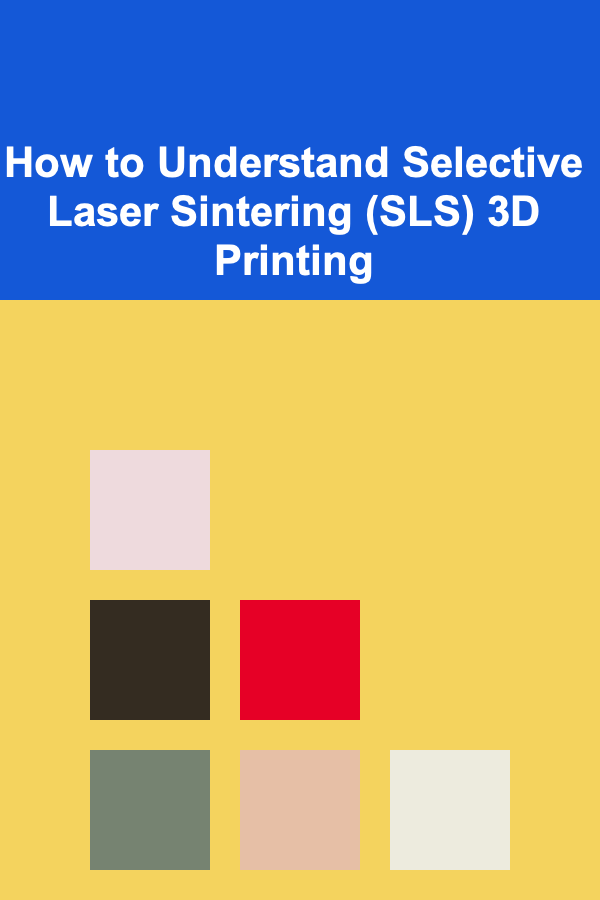
How to Understand Selective Laser Sintering (SLS) 3D Printing
ebook include PDF & Audio bundle (Micro Guide)
$12.99$6.99
Limited Time Offer! Order within the next:

Selective Laser Sintering (SLS) is one of the most advanced and versatile 3D printing technologies in use today. Originating from the need to create complex, precise, and durable objects, SLS has evolved to serve a variety of industries, including aerospace, automotive, medical, and consumer goods. In this comprehensive article, we will explore the science behind SLS, its workflow, benefits, limitations, and its impact on industries. By the end, you will have a deeper understanding of why SLS is often the go-to technology for rapid prototyping and low-volume manufacturing.
What Is Selective Laser Sintering (SLS)?
Selective Laser Sintering is a 3D printing or additive manufacturing process that uses a high-powered laser to fuse particles of a powdered material into solid structures. The process starts with a thin layer of powder being spread across the build platform. The laser then selectively heats and fuses the powder particles together based on the design specifications. This process is repeated layer by layer until the entire object is formed.
SLS can utilize various materials, including plastics, metals, ceramics, and glass, though plastic powders such as nylon and its derivatives are among the most common. Unlike other 3D printing methods, SLS does not require support structures since the unsintered powder itself acts as a support material for the object being printed.
The Science Behind SLS Technology
At its core, SLS relies on the principles of sintering, which involves heating material below its melting point to just the point where its particles begin to fuse together. In Selective Laser Sintering, this is achieved with a precisely focused laser beam that scans the powder surface according to the digital model.
The Laser and Powder Interaction
The laser in SLS is usually a CO2 laser, which is capable of delivering the necessary energy to sinter the powder. As the laser moves across the powder bed, it heats the particles just enough to fuse them together, but not so much that they melt completely. This process creates a solidified layer of material that forms the base for the next layer.
The powdered material used in SLS typically has a grain size ranging from 20 to 50 microns, depending on the material. The laser's energy is absorbed by the powder particles, causing them to bind and form a solid layer. Once the laser has scanned the entire cross-section of the design, the build platform lowers by one layer thickness, and a new layer of powder is spread over the previous layer. This cycle continues, creating a multi-layer structure.
Thermal Effects and Material Properties
Because SLS uses a laser to heat the powder, the thermal effects on the material can be significant. The thermal gradients created during the sintering process can influence the mechanical properties of the final part. The cooling rate is crucial, as it can lead to internal stresses that may cause warping or distortion. To mitigate this, SLS systems are often equipped with temperature-controlled environments or ovens that ensure a uniform build process.
Additionally, the choice of material can significantly impact the properties of the printed object. For example, SLS is known for creating parts with excellent mechanical strength, high chemical resistance, and good thermal stability, making it suitable for demanding applications such as functional prototypes and end-use parts.
The SLS Workflow
To get a better understanding of SLS, it's essential to explore the typical workflow that takes place in an SLS-based 3D printing system. This process is generally divided into several stages: design, preparation, printing, and post-processing.
1. Design
The first step in the SLS process is designing the 3D model of the object to be printed. This design is usually created using Computer-Aided Design (CAD) software. The model must be converted into a format that the SLS machine can read, typically STL or OBJ files. The design can be anything from a simple geometric shape to complex, organic forms that would be difficult or impossible to produce using traditional manufacturing methods.
2. Preparation
Once the design is complete, it is imported into the SLS machine's slicing software. This software slices the 3D model into thin layers and generates a toolpath for the laser to follow. The software also allows for the optimization of settings such as layer height, laser power, and print speed to achieve the best results.
The material is loaded into the printer, typically in the form of a powder bed. The build platform is also prepared, ensuring that it is clean and level.
3. Printing
With the machine prepared, the printing process begins. The first layer of powder is spread across the build platform, and the laser starts to sinter the powder according to the design specifications. The laser scans the cross-sectional shape, and the platform lowers slightly to allow for the addition of the next powder layer.
This process is repeated for each layer, with the laser continuing to sinter the material layer by layer. Depending on the complexity and size of the part, this stage can take anywhere from a few hours to several days.
4. Post-Processing
Once the printing is completed, the part is not yet fully ready for use. Since SLS does not require support structures, the unsintered powder remains around the printed object. This powder needs to be removed carefully in a post-processing stage. This can involve shaking or blasting the part to remove the excess powder, or even using vacuum or air pressure systems to extract the material from hard-to-reach areas.
After the powder is removed, the part may need further finishing, such as smoothing, painting, or coating, to meet specific aesthetic or functional requirements.
Materials Used in SLS
One of the key advantages of SLS is its ability to work with a wide range of materials. These materials are typically powders that can be fused together by the laser's heat. The most common materials used in SLS are:
1. Nylon (Polyamide)
Nylon-based powders are the most popular choice for SLS printing due to their versatility, strength, and durability. They are used to create parts with high tensile strength, good resistance to wear, and resistance to chemicals. Nylon is often used for both functional prototypes and end-use parts.
2. Metal Powders
SLS can also print with metal powders, such as stainless steel, titanium, and aluminum. Metal SLS printing is more expensive and requires additional post-processing, such as sintering in a furnace to fully solidify the metal parts. Metal SLS is commonly used in aerospace, automotive, and medical applications where high precision and strength are required.
3. Ceramics
Ceramic powders are less common but are used in applications where high heat resistance and specific mechanical properties are required. SLS-printed ceramic parts often undergo additional firing in a furnace after printing to achieve the necessary hardness and finish.
4. Composite Materials
SLS can also be used with composite powders, which combine materials like glass fibers, carbon fibers, or mineral additives with a polymer base. These composites enhance the mechanical properties of the printed parts, making them more rigid or lightweight, depending on the application.
Advantages of SLS 3D Printing
SLS has a number of unique advantages that make it a standout in the world of 3D printing:
1. Complex Geometries
SLS can print complex geometries that are difficult, if not impossible, to achieve with traditional manufacturing methods. The technology allows for intricate internal structures, overhangs, and organic shapes that are often used in aerospace and medical industries.
2. No Need for Support Structures
Unlike other 3D printing technologies such as Fused Deposition Modeling (FDM) or stereolithography (SLA), SLS doesn't require external support structures for overhangs or delicate features. The unsintered powder itself provides support during the printing process, which results in fewer post-processing steps and reduces material waste.
3. Strong and Durable Parts
Parts created using SLS technology tend to have strong mechanical properties, including high tensile strength, impact resistance, and chemical durability. This makes SLS an excellent choice for functional prototypes and low-volume manufacturing of end-use parts.
4. Variety of Materials
As mentioned earlier, SLS can print with a wide variety of materials, including plastics, metals, ceramics, and composites. This versatility opens up many possibilities for different industries and applications.
Limitations of SLS 3D Printing
While SLS offers many benefits, it does have its limitations, including:
1. Cost
SLS equipment and materials tend to be more expensive than other 3D printing technologies. This can make it less accessible for small businesses or individuals, particularly when used for prototyping rather than large-scale production.
2. Long Printing Times
Depending on the complexity and size of the object, SLS printing can be slow. This is especially true when working with large parts or multi-part builds. The post-processing stage can also add time to the overall process.
3. Surface Finish
While SLS produces durable parts, the surface finish may not be as smooth as parts made with other technologies, such as SLA. This means that additional post-processing steps like sanding, polishing, or coating may be necessary for aesthetic purposes.
Applications of SLS 3D Printing
SLS 3D printing is used in a wide range of industries and applications, including:
- Aerospace: SLS is used to create lightweight, complex components for aircraft and spacecraft.
- Automotive: Engineers use SLS to produce functional parts, prototypes, and tooling for the automotive industry.
- Medical: SLS is used to create custom implants, prosthetics, and surgical tools.
- Consumer Goods: Companies use SLS for rapid prototyping and producing functional parts for consumer electronics, fashion, and other products.
Conclusion
Selective Laser Sintering is a powerful and versatile 3D printing technology that has revolutionized the way we create complex, functional parts. With its ability to print a variety of materials, including plastics, metals, and composites, SLS offers unique advantages over other manufacturing methods, particularly in industries that require high precision and durability. However, it is not without its limitations, such as cost and long printing times. Nonetheless, as technology advances, we can expect SLS to continue to play an essential role in the world of additive manufacturing, offering new opportunities for innovation and efficiency.

How to Cut Back on Subscriptions and Entertainment Costs at Home
Read More
How to Optimize Your Internet Connection for Remote Work
Read More
How to Protect Your Home During a Power Outage
Read More
How To Master Robot Gripper Design
Read More
How to Crochet Waterproof Crochet Bags
Read More
10 Tips for Preventing Radiation Exposure in the Radiography Department
Read MoreOther Products

How to Cut Back on Subscriptions and Entertainment Costs at Home
Read More
How to Optimize Your Internet Connection for Remote Work
Read More
How to Protect Your Home During a Power Outage
Read More
How To Master Robot Gripper Design
Read More
How to Crochet Waterproof Crochet Bags
Read More